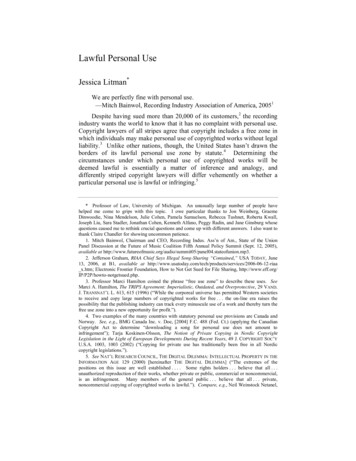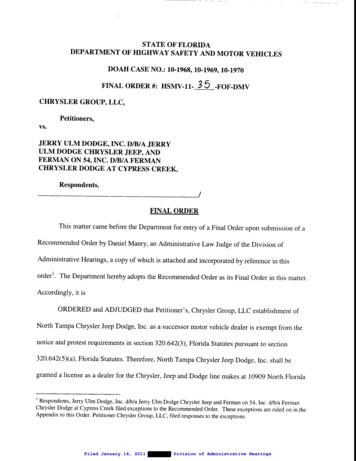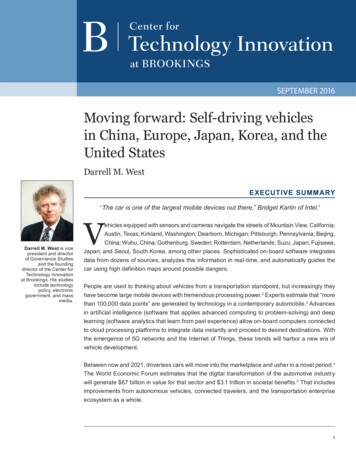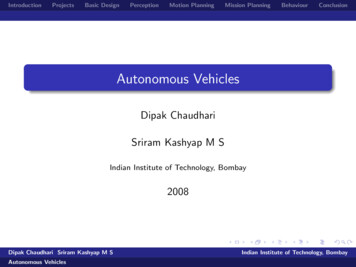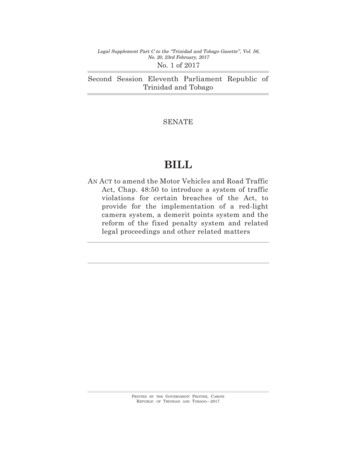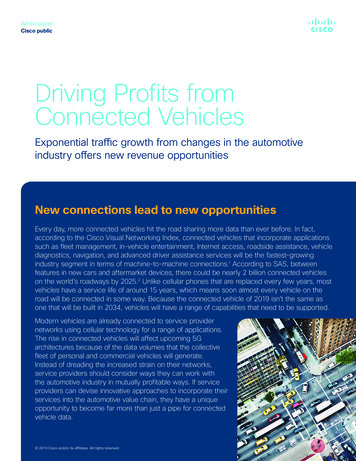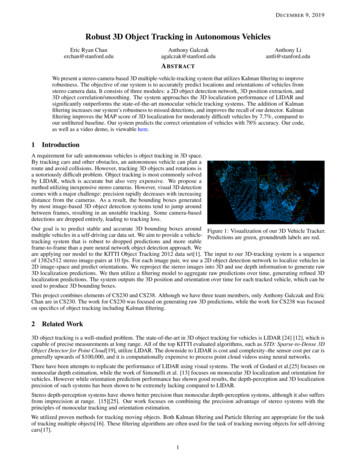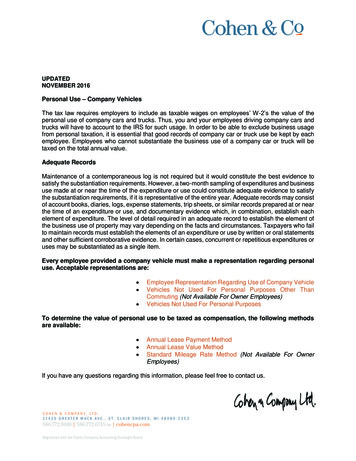
Transcription
UPDATEDNOVEMBER 2016Personal Use – Company VehiclesThe tax law requires employers to include as taxable wages on employees’ W-2’s the value of thepersonal use of company cars and trucks. Thus, you and your employees driving company cars andtrucks will have to account to the IRS for such usage. In order to be able to exclude business usagefrom personal taxation, it is essential that good records of company car or truck use be kept by eachemployee. Employees who cannot substantiate the business use of a company car or truck will betaxed on the total annual value.Adequate RecordsMaintenance of a contemporaneous log is not required but it would constitute the best evidence tosatisfy the substantiation requirements. However, a two-month sampling of expenditures and businessuse made at or near the time of the expenditure or use could constitute adequate evidence to satisfythe substantiation requirements, if it is representative of the entire year. Adequate records may consistof account books, diaries, logs, expense statements, trip sheets, or similar records prepared at or nearthe time of an expenditure or use, and documentary evidence which, in combination, establish eachelement of expenditure. The level of detail required in an adequate record to establish the element ofthe business use of property may vary depending on the facts and circumstances. Taxpayers who failto maintain records must establish the elements of an expenditure or use by written or oral statementsand other sufficient corroborative evidence. In certain cases, concurrent or repetitious expenditures oruses may be substantiated as a single item.Every employee provided a company vehicle must make a representation regarding personaluse. Acceptable representations are: Employee Representation Regarding Use of Company VehicleVehicles Not Used For Personal Purposes Other ThanCommuting (Not Available For Owner Employees)Vehicles Not Used For Personal PurposesTo determine the value of personal use to be taxed as compensation, the following methodsare available: Annual Lease Payment MethodAnnual Lease Value MethodStandard Mileage Rate Method (Not Available For OwnerEmployees)If you have any questions regarding this information, please feel free to contact us.C OHEN & C OMPAN Y, LT D.21420 G RE AT E R M AC K AV E ., S T. C L A IR SH O RE S, M I 4 8 0 8 0 -235 3586.772.8100 586.772.6715 fax cohencpa.comRegistered with the Public Company Accounting Oversight Board
EMPLOYEE REPRESENTATION REGARDINGUSE OF COMPANY VEHICLE2016The IRS requires employers to provide certain information on their tax return with respect to thevehicles provided to employees. This information is also used to calculate the amount of the fringebenefit to be included in the employee’s W-2 income.The IRS generally requires that written records be maintained to document the business use ofvehicles. Since the company policy requires employees to maintain the detailed records, pleaseprovide answers to the following questions. If you were provided more than one vehicle that was usedduring the year, you need to prepare a separate statement for each vehicle.The completed form must be returned no later thanincluded in the employee’s W-2 income.Description of vehicleReporting period fromOdometer reading: Beginningor 100% of the value will be(date)toEndingEMPLOYEE REPRESENTATION:1.Was the vehicle available for your personal use during off-duty hours?YESNO2.Did you have another vehicle available for your personal use (thisincludes a car you own personally)?YESNO3.Are you an officer or 1% owner of the business?YESNO4.How many commuting round trips did you make in this vehicle?5.For the reporting period specified above, please provide the number ofmiles for each of the following categories:YESNOTotal commuting milesTotal other personal (non-commuting) milesTotal personal milesTotal business milesTOTAL MILES6.Did the employer pay the cost of fuel consumed by this vehicle?(Employee signature)(Date)*Reporting period can be the calendar year or it can be a fiscal year (12 month period) ending either October 31 orNovember 30 in order to expedite your payroll tax return filings.
VEHICLES NOT USED FOR PERSONAL PURPOSES OTHER THAN COMMUTINGManagement has adopted the following policy regarding personal use of Company ownedvehicles:For business reasons, certain employees have been designated to drive aCompany owned vehicle to and from their residence. This shall be the onlyauthorized personal use of the vehicle. Individuals driving Company vehiclesmay have occasions where an incidental stop is necessary between businessstops. Such use shall not be considered to be in violation of this policy.The Company requires that no personal items other than incidentals be storedin the vehicle. The vehicle is to be locked each night with work articles storedeither in the lock box or trunk during times when the vehicle is not in use.The Company will compute a daily value for the commuting which will beincluded in the employee’s W-2 at the end of the calendar year. Such amountwill be the minimum allowed by federal income laws.CALCULATIONEmployee:Description of Vehicle:Date Vehicle First Made Available To Any Employee:Date Vehicle First Made Available To This Employee:Number of commuting round trips madeValue per round tripxPersonal use taxable income 3.00If the following criteria are met, employees may be taxed on this method:(1)The vehicle must be owned or leased by the employer and provided to one or more employees for usein connection with the employer’s trade or business.(2)For bona fide noncompensatory reasons, the employer requires the employee to commute to and/orfrom work in the vehicle.(3)The employer has established a written policy under which neither the employee or any individual whoseuse would be taxable to the employee may use the vehicle for personal purposes other than de minimispersonal use.(4)Except for de minimis use, neither the employee nor any individual whose use would be taxable to theemployee may use the vehicle for any personal purpose other than commuting.(5)The employee required to use the vehicle for commuting must not be a control employee of the employer.A control employee is a director, officer, or one percent owner of the employer. The value of commutingwill be 1.50 per trip and included as compensation on the employee’s W-2.
VEHICLES NOT USED FOR PERSONAL PURPOSESManagement has adopted the following policy regarding personal use of Company ownedvehicles:Vehicles owned or leased by this Company are to be used solely for Companybusiness. There shall be no personal use of the vehicles (including commutingto and from work). Individuals driving Company vehicles may have occasionswhere an incidental stop is necessary between business stops. Such use shallnot be considered to be in violation of this policy.The Company requires that vehicles not in use shall be parked in designatedareas on the Company premises. No personal items are to be stored in thevehicles. Company materials and supplies are to be secured in the trunk, lockboxes or within the Company offices.Keys are to be returned toupon the close of business each day.Description of Vehicles:A policy statement that prohibits personal use by an employee satisfies an employer’ssubstantiation requirements under the law if all the following conditions are met and evidenceexists that would enable the IRS to determine whether the use of the vehicle meets theconditions.(1)The vehicle owned or leased by the employer is provided to one or more employeesfor use in connection with the employer’s trade or business;(2)When the vehicle is not being used for such business purposes, it is kept on theemployer’s business premises (or temporarily located elsewhere, e.g., for repair);(3)No employee using the vehicle lives at the employer’s business premises;(4)Under the employer’s written policy, no employee (or any individual whose use ofthe vehicle would result in gross income to the employee) may use the vehicle forpersonal purposes, other than de minimis personal use (such as a stop for lunchbetween two business deliveries); and(5)The employer reasonably believes that, except for de minimis use, no employeeuses the vehicle for any personal purpose.
ANNUAL LEASE PAYMENT METHODEMPLOYER’S WORKSHEET TO CALCULATE EMPLOYEE’S TAXABLEINCOME RESULTING FROM EMPLOYER-PROVIDED VEHICLE2016Employee:Description of Vehicle:Date Vehicle First Made Available To Any Employee:Date Vehicle First Made Available To This Employee:Actual lease value:(monthly payment multiplied including sales tax)by (number of months car leased){A}(total miles) multiplied by .055{B}Add {A} and {B}{C}Personal percentage (per statement from employee){D}Taxable benefit to be reported on W2 (Multiply {C} by {D}){E}
ANNUAL LEASE VALUE METHODEMPLOYER’S WORKSHEET TO CALCULATE EMPLOYEE’S TAXABLEINCOME RESULTING FROM EMPLOYER-PROVIDED VEHICLE2016Employee:Description of Vehicle:Date Vehicle First Made Available To Any Employee:Date Vehicle First Made Available To This Employee:Fair market value of vehicle (to be redetermined at the beginningof the fifth year and every four years thereafter){A} (1)Annual lease value, per attached chart{B} (2)Prorated Annual Lease Value [Skip {C} through {E} if car is heldall year or is held less than 30 days]:Enter number of days during the year that the vehicle wasavailable{C}Divide by number of days in tax year{D}Prorated annual lease value [{D} times {B}]{E}Personal use % (personal/total miles, per statement fromemployee){F}Personal annual lease value [{B} or {E} times {F}]{G}%%If fuel is provided by employer, enter personal milesx (3)Personal use taxable income [{G} {H} {I}]{H}{I} (1)Fair value is the purchase price of the automobile or the sticker price less 8% plus tax and license ofa leased auto.(2)For autos available for one or more but less than 30 days, the value of availability of the employerprovided automobile is the Daily Lease Value. The Daily Lease Value is calculated by multiplying theapplicable Annual Lease Value by a fraction, the numerator of which is four times the number of daysof availability and the denominator of which is 365.(3)If fuel is provided “in kind”, the fair market value may be determined based on all facts andcircumstances or, alternatively, at 5-1/2 cents per mile. Generally, where fuel is purchased andcharged to the employer, the actual cost or reimbursement should be used. If employers with a fleetof 20 or more vehicles reimburse or allow employees to charge fuel cost, the fleet-average cents permile may be used. If the fleet employer determines that actual cost or fleet average methods areunreasonable administrative burdens, the 5-1/2 cents per mile may be used.
Annual Lease Value Table for Automobiles(1)Automobile FairMarket Value 0-(2)Annual LeaseValue(1)Automobile FairMarket Value(2)Annual LeaseValue999. 600 22,000 - 22,999. 6,1001,000 - 1,999.85023,000 - 23,999.6,3502,000 - 2,999.1,10024,000 - 24,999.6,6003,000 - 3,999.1,35025,000 - 25,999.6,8504,000 - 4,999.1,60026,000 - 27,999.7,2505,000 - 5,999.1,85028,000 - 29,999.7,7506,000 - 6,999.2,10030,000 - 31,999.8,2507,000 - 7,999.2,35032,000 - 33,999.8,7508,000 - 8,999.2,60034,000 - 35,999.9,2509,000 - 9,999.2,85036,000 - 37,999.9,75010,000 - 10,999.3,10038,000 - 39,999.10,25011,000 - 11,999.3,35040,000 - 41,999.10,75012,000 - 12,999.3,60042,000 - 43,999.11,25013,000 - 13,999.3,85044,000 - 45,999.11,75014,000 - 14,999.4,10046,000 - 47,999.12,25015,000 - 15,999.4,35048,000 - 49,999.12,75016,000 - 16,999.4,60050,000 - 51,999.13,25017,000 - 17,999.4,85052,000 - 53,999.13,75018,000 - 18,999.5,10054,000 - 55,999.14,25019,000 - 19,999.5,35056,000 - 57,999.14,75020,000 - 20,999.5,60058,000 - 59,999.15,25021,000 - 21,999.5,850For automobiles with a fair market valuegreater than 59,999, the annual lease valueis: (.25 x fair market value) 500.To compute the annual lease value, first determine fair market value (FMV) as of the first date an autois made available to any employee for personal use. Under safe harbor rules, where the auto is boughtin an arm’s length purchase by the employer, the FMV is the cost, including sales tax, title fees andother purchase expenses. Where leased, it is the suggested retail price less 8%, the retail value asreported in a nationally recognized publication that regularly reports such values, (Reg. Section 1.6121(d)(5)) or the manufacturer’s invoice price plus 4%. Then, find the dollar range in column (1) of theabove table which corresponds to the FMV of the automobile. The corresponding amount in column(2) is the auto’s annual lease value. (Reg. Section 1.61-21(d)(2)(iii)).
STANDARD MILEAGE RATE METHODEMPLOYER’S WORKSHEET TO CALCULATE EMPLOYEE’S TAXABLEINCOME RESULTING FROM EMPLOYER-PROVIDED VEHICLE2016Employee:Description of Vehicle:Date Vehicle First Made Available To Any Employee:Date Vehicle First Made Available To This Employee:Generally, in order to qualify to use the cents-per-mile method, the vehicle must:1. be expected to be regularly used in the employer’s business throughout the calendaryear, or2. be driven at least 10,000 miles per year, and3. have a fair market value of less than the 280 F limits ( 15,900 for vehicles first placed inservice in 2016 & 17,700 for a truck or van), and4. not available for owner/employee.Once this method is adopted for a particular vehicle, it must be continued until the vehicle nolonger qualifies. Enter personal miles for 1/1 – 12/31 If fuel is NOT provided by theemployer, enter personal miles Personal use taxable income(Subtract Line 2 from Line 1)x .54 x .055 ( )
Personal Use – Company Vehicles The tax law requires employers to include as taxable wages on employees’ W-2’s the value of the personal use of company cars and trucks. Thus, you and your employees driving company cars and trucks will have to account to the IRS for such usage. In or
